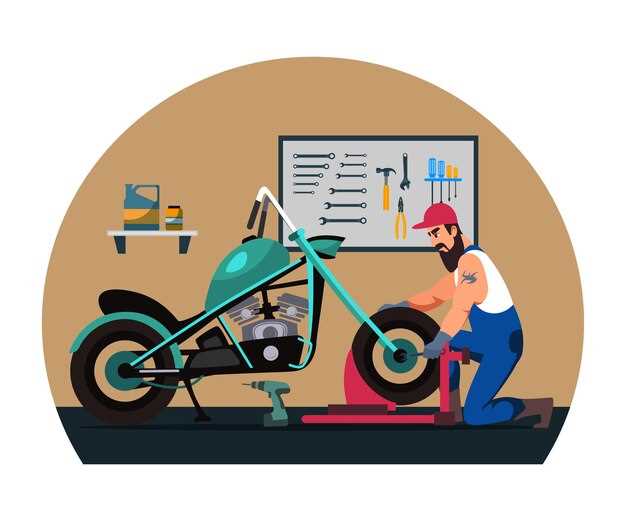Upgrade your motorcycle’s performance by regularly checking and maintaining tire pressure. Properly inflated tires improve grip and handling, ensuring a smoother and more responsive ride. Use a reliable pressure gauge to keep your tires at the manufacturer’s recommended levels, and check them before every ride. This simple step can significantly enhance your overall control and safety on the road.
Next, consider optimizing your engine’s air intake. Replacing the stock air filter with a high-flow option facilitates better airflow, which can increase horsepower and throttle response. Regularly clean or replace your air filter to maintain optimal engine performance. A clean filter not only boosts power but also improves fuel efficiency.
Don’t overlook the importance of regular oil changes. Fresh, high-quality oil reduces friction within the engine, resulting in smoother operation and longer engine life. Check your oil levels regularly and change it according to your bike’s service schedule. Using the right oil viscosity can also maximize engine performance and response.
Lastly, examine your motorcycle’s suspension. Well-maintained suspension components play a critical role in ride quality and handling. Adjusting the settings based on your weight and riding style can make a noticeable difference. A smoother suspension enhances comfort and control, leaving you free to enjoy every ride.
Optimize Tire Pressure for Better Grip and Handling
Check and maintain your tire pressure regularly. Keeping tires inflated to the manufacturer’s recommended psi significantly improves grip and handling. Under-inflated tires increase rolling resistance, while over-inflated ones can lead to reduced contact with the road.
Use a reliable digital or analog tire pressure gauge for accuracy. Measure pressure when tires are cold for the best results, typically before your ride. If you need to adjust, make sure to add or release air, aiming for the optimal range set in your motorcycle’s manual.
Pay attention to the type of riding you do. Different conditions may require slight adjustments. For track days, a slightly lower pressure can enhance grip, while touring may benefit from higher pressure for improved fuel efficiency. Always revert to standard settings after special conditions.
Regularly inspect tire wear patterns as well. Uneven wear can indicate incorrect pressure. If you notice cupping or excessive wear on one side, it may signal the need for adjustments or professional inspection.
Lastly, consider seasonal changes. Temperature fluctuations affect tire pressure–cold weather decreases it, while heat increases it. Check pressure more frequently during these transitions to ensure optimal performance.
Upgrade Your Air Filter for Improved Engine Breathing
Replace your stock air filter with a high-flow aftermarket version for enhanced airflow. This upgrade allows your engine to breathe more freely, increasing throttle response and power delivery.
Choose a filter made from premium materials like cotton or foam, which offer better filtration and airflow compared to paper filters. Brands like K&N and JMT come highly recommended for their balance of performance and longevity.
Regular maintenance is key. Clean your air filter according to the manufacturer’s recommendations to maintain optimal performance. A clean filter ensures maximum airflow and keeps debris from entering the engine.
Consider pairing your new air filter with an upgraded exhaust system. This combination optimizes airflow in and out of the engine, further enhancing performance and efficiency.
Monitor your motorcycle’s air-fuel ratio after upgrading. Using a fuel management system may be necessary to fine-tune the bike’s performance and avoid running too lean, which can lead to engine damage.
With a quality air filter in place, your motorcycle will experience improved acceleration, better fuel efficiency, and heightened overall performance. Enjoy the ride with your upgraded setup!
Maintain Your Chain for Smooth Power Delivery
Check your chain tension regularly. Aim for about 1 to 1.5 inches of slack. Proper tension ensures optimal power transfer from the engine to the rear wheel. Use a tape measure or finger measurement method along the chain’s length to assess slack.
Clean your chain frequently. Dirt and grime can accumulate and hinder performance. Use a chain cleaner or degreaser along with a brush to remove contamination, then rinse with water and dry. After cleaning, apply a quality chain lubricant to minimize wear.
Examine the sprockets for wear. Worn sprockets can lead to poor chain alignment and reduced efficiency. Look for hooked or missing teeth, and if they appear damaged, replace them alongside the chain to maintain compatibility.
Adjust your chain alignment to prevent unnecessary wear and ensure a smooth ride. Use the rear axle adjusters to align the wheel properly, checking both sides to maintain balance. This step enhances overall handling and power delivery.
Inspect for kinks or stiff links. A chain should move smoothly without binding. If you find stiff links, try to work them loose or replace the chain if issues persist. A smooth chain reduces friction for better acceleration.
Keep an eye on the chain’s lifespan. Most chains have a wear indicator; if it stretches beyond the recommended limit, it’s time for a replacement. Replacing a worn chain promotes smoother transfers and protects your sprockets.
| Action | Frequency |
|---|---|
| Check chain tension | Every 200-300 miles |
| Clean chain | Every 500 miles |
| Inspect sprockets | Every 1000 miles |
| Check for stiff links | Every maintenance session |
| Replace chain/sprockets | As needed, check wear indicators |
By maintaining your motorcycle’s chain, you enhance performance and increase durability, ensuring a smoother ride and more responsive handling. Regular upkeep pays off in both efficiency and longevity of your motorcycle’s drivetrain.
Choose the Right Fuel for Peak Performance
Select premium fuel with higher octane ratings for optimal motorcycle performance. This fuel burns cleaner and prevents knocking, allowing your engine to operate efficiently.
Check your owner’s manual for the manufacturer’s recommended octane level. Using a lower octane than specified can lead to engine damage, and using a higher octane than needed typically doesn’t provide additional benefits.
Consider ethanol content when choosing fuel. Ethanol can absorb moisture and impact performance. Look for fuel with 10% ethanol or less, especially for older motorcycles, which may not be compatible with higher concentrations.
Use fresh fuel for your motorcycle. Older fuel can degrade and lose its combustibility, affecting performance. Always try to purchase fuel from reputable sources to ensure quality.
Incorporate fuel additives designed for motorcycle engines. Cleaners and stabilizers can enhance combustion and improve fuel economy, giving your bike a noticeable boost in performance.
Regularly check and replace fuel filters to maintain optimal fuel flow. A clogged filter can restrict fuel supply, leading to performance issues. Stay proactive with maintenance for best results.
Consider your riding conditions. If you frequently ride in extreme temperatures or elevations, pick a fuel blend that suits those conditions to enhance your engine’s efficiency and responsiveness.
By carefully choosing the right fuel, you can significantly improve your motorcycle’s performance and enjoy a smoother, more powerful ride every time you hit the road.
Regularly Clean and Adjust Your Brakes for Safety
Inspect your brakes every month for dirt, dust, or debris. Use a microfiber cloth and brake cleaner to wipe down the calipers, rotors, and brake pads. This keeps the braking system functioning smoothly and increases responsiveness.
Check the brake pads for wear. If the pads are less than 1/8 inch thick, replace them. Worn pads can reduce stopping power and increase braking distance, making it harder to stop quickly in emergencies.
Adjust the brake lever or pedal to fit your hand and foot comfortably. This helps you apply pressure without straining and ensures optimal control. A good position allows for easier, more immediate braking when needed.
Inspect brake fluid levels regularly. If the fluid appears dark or contaminated, flush the system and replace it with fresh fluid. Contaminated fluid can lead to decreased braking efficiency and potential brake failure.
Pay attention to the brake lines for any signs of wear or leaks. Replace damaged lines immediately to prevent loss of brake pressure. Ensure all connections are tight and secure to avoid any fluid leaks.
Test your brakes periodically while riding. Listen for unusual noises or changes in how the brakes feel. Any irregularities could indicate issues that need addressing. Trust your instincts; if something feels off, investigate it right away.
Invest in Lightweight Accessories to Improve Speed
Choosing lightweight accessories can significantly enhance your motorcycle’s speed and performance. Consider the following options:
- Carbon Fiber Components: Replace heavy parts like fenders and hoods with carbon fiber alternatives. These materials drastically reduce weight while maintaining strength.
- Aluminum Parts: Switch to aluminum components for areas such as handlebars, rims, and brake calipers. Aluminum is durable and much lighter than steel.
- Lightweight Exhaust Systems: Invest in a high-performance exhaust system made from lightweight materials. This not only reduces weight but can also improve engine efficiency.
- Streamlined Fairings: Install fairings designed with weight reduction in mind. They can significantly decrease drag, allowing for better acceleration.
Each of these additions contributes to a lighter overall load. To maximize the benefits, always check compatibility and ensure proper installation. Regularly assess the condition of your accessories to avoid unnecessary weight accumulation from wear and tear.
Monitor your motorcycle’s performance after each change. You’ll likely notice improved handling and quicker response times. By continuously optimizing your bike with lightweight accessories, you create an agile machine ready for any ride.







